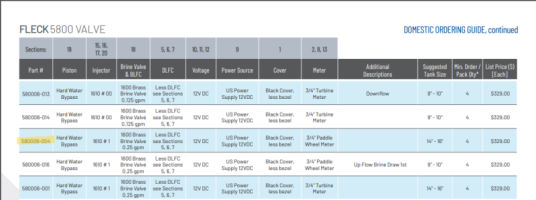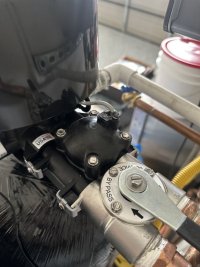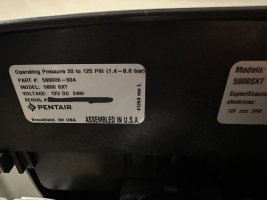A new install by a dealer on I used on Yelp, installed a Upflow 2.5cu ft catalytic carbon and a Fleck 5800 SXT 2.5cu ft 80k water softener. From what I understand trying to learn from several post. I am having trouble with getting my water to be "soft / slippery". When it was first installed and running, the water felt very slippery / taste clean and mildly sweet. Now after a month, it lost its softness. I checked the SXT settings and of course, all were default settings, never programed.
So after Programming, running a regeneration cycle, it still does not feel soft, but regular tap / slightly salty.
Sticker Found under my SXT model
Sticker on brine line states Injector #1 and 0.25 GPM.
(From Manual) Pentair Serial #: 580006-004 - Paddle Wheel Meter, Downflow Softener, U.S. Power Supply, #1 Injector, 0.25 GPM BLFC
(Attached is ordering guide for SXT 5800 models)
My home main waterline PSI ~90, with post bibb ~85 PSI
5800SXT System
City Water
salt lb/cuft : 8.0
BLFC : 0.25 GPM
cubic ft resin : 2.5 / 80k
Raw hardness : 22.0 (compensated 1.12 / no iron)
Estimated gal/day 300.0 ; 60gal/person
Est days/regen ???
Fleck 5800SXT Settings (Current):
DF = Gal ; Units
VT = 5800 ; Valve type
RF = dF1b
CT = Fd ; Meter Delayed regen trigger
C = 60 ; capacity in 1000 grains
H = 22 ; Hardness grains after comp factor
RS = cr ;
DO = 14 ; Day Override (typ 28 if no iron/Mn)
RT = 3:45 ; Regen time (default 2 AM)
Bw = 10 ; Backwash 1 (minutes) [3...10]
Bd = 60 ; Brine draw minutes
RR = 10 ; Rapid Rinse minutes [5...10]
BF = 27 ; Brine fill minutes
FM = P0.7 (3/4 paddle wheel downflow)
1st force regeneration, I have tried dF2b, C = 80k, B1 = 5, Bd = 60, B2 = 5, RR = 10, BF 27 resulted the water to be extremely salty.
2nd force regeneration, I followed that with a dF1b, C = 60k, BW 10, Bd = 60, RR 10, BF 27 resulted tap water consistency.
Much help appreciated! Thank you.
So after Programming, running a regeneration cycle, it still does not feel soft, but regular tap / slightly salty.
Sticker Found under my SXT model
Sticker on brine line states Injector #1 and 0.25 GPM.
(From Manual) Pentair Serial #: 580006-004 - Paddle Wheel Meter, Downflow Softener, U.S. Power Supply, #1 Injector, 0.25 GPM BLFC
(Attached is ordering guide for SXT 5800 models)
My home main waterline PSI ~90, with post bibb ~85 PSI
5800SXT System
City Water
salt lb/cuft : 8.0
BLFC : 0.25 GPM
cubic ft resin : 2.5 / 80k
Raw hardness : 22.0 (compensated 1.12 / no iron)
Estimated gal/day 300.0 ; 60gal/person
Est days/regen ???
Fleck 5800SXT Settings (Current):
DF = Gal ; Units
VT = 5800 ; Valve type
RF = dF1b
CT = Fd ; Meter Delayed regen trigger
C = 60 ; capacity in 1000 grains
H = 22 ; Hardness grains after comp factor
RS = cr ;
DO = 14 ; Day Override (typ 28 if no iron/Mn)
RT = 3:45 ; Regen time (default 2 AM)
Bw = 10 ; Backwash 1 (minutes) [3...10]
Bd = 60 ; Brine draw minutes
RR = 10 ; Rapid Rinse minutes [5...10]
BF = 27 ; Brine fill minutes
FM = P0.7 (3/4 paddle wheel downflow)
1st force regeneration, I have tried dF2b, C = 80k, B1 = 5, Bd = 60, B2 = 5, RR = 10, BF 27 resulted the water to be extremely salty.
2nd force regeneration, I followed that with a dF1b, C = 60k, BW 10, Bd = 60, RR 10, BF 27 resulted tap water consistency.
Much help appreciated! Thank you.
Attachments
Last edited:



